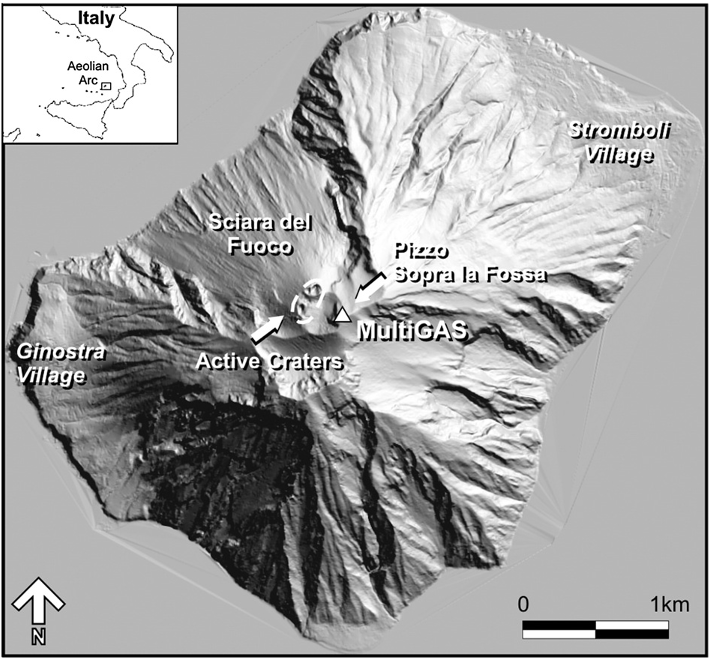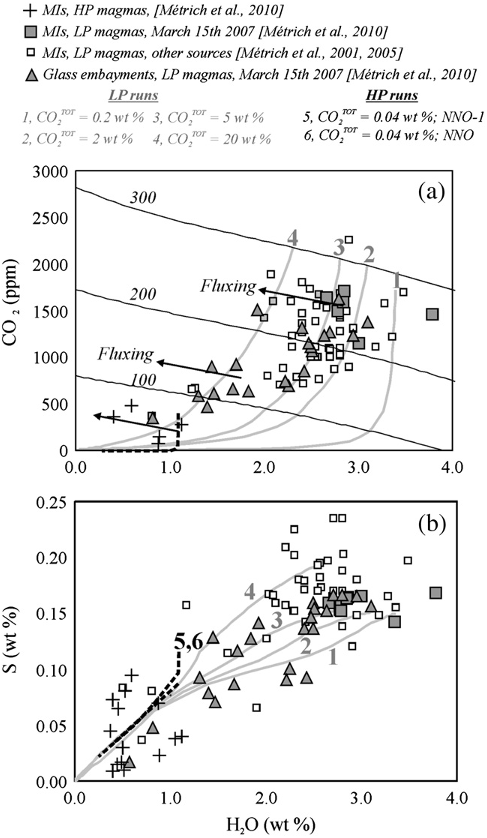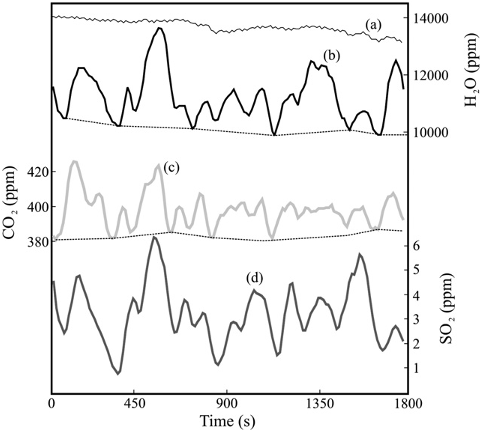A model of degassing for Stromboli volcano
Alessandro Aiuppa,Antonella Bertagnini,Nicole Métrich,Roberto Moretti,A. Di Muro,Marco Liuzzo,Giancarlo Tamburello +6 more
Reads0
Chats0
TLDR
In this article, the authors used the MultiGAS technique to provide the best documented record of gas plume discharges from Stromboli volcano to date, and showed that Strombolian's gases are dominated by H2O (48−98−mol); mean, 80%), and by CO2 (2−50−mol%; mean, 17%) and SO2 (0.2−14−mol; mean, 3%).About:
This article is published in Earth and Planetary Science Letters.The article was published on 2010-06-15 and is currently open access. It has received 144 citations till now. The article focuses on the topics: Strombolian eruption & Volcanic Gases.read more
Figures

Fig. 6. Schematic cross-section showing the main features of Stromboli's crustal plumbing system (modified from Métrich et al., 2010). See text for discussion. 
Fig. 1. A map of Stromboli showing the location of the permanent MultiGAS on Pizzo Sopra la Fossa. 
Fig. 7. Volatile abundances in Stromboli's melt inclusions and glass embayments contrasted against results of the saturation model. Data fromMétrich et al. (2001, 2005, 2009) and Bertagnini et al. (2003). (a) H2O vs. CO2; (b) H2O vs. S. The grey solid lines are model results from LP runs 1–4, whilst black dashed lines show model results from HP runs 5–6. Comparison of natural and modelled compositions confirms that the deep (PN100 MPa) LP magma contains a high (2–5 wt.%; model curves 2–3) fraction of gas bubbles at reservoir conditions. Glass embayment formed at P∼100 MPa are H2Opoorer than predicted by model curves 2–3, suggesting some extent of gas fluxing with CO2-rich gas bubbles. This triggers de-hydratation of the LP magma, and probably controls transition to HP magma. The same process likely occurs also in the upper conduit system (compare model trends 5–6 with volatile abundances in HP magmas). In a, isobars are traced under a fixed Fe2/Fetot ratio of 0.24 (Table 2), and are thus slightly different than those originally reported byMétrich et al. (2010) (who, yet using the same saturation model, used a constant ΔNNO value, thus yielding variable Fe2/Fe3 proportions depending on melt composition, and water particularly). 
Table 1 Compositions of Stromboli's volcanic gas plume (in mol%). We derive compositions for both the bulk plume (essentially contributed by persistent passive degassing) and the syn-explosive plume (the gas jet of a Strombolian explosion, reaching the MultiGAS a few seconds after the burst, and before being diluted in the main plume). 
Fig. 2. An example of a 1800 sMultiGAS acquisition at Stromboli (acquisition frequency, 9 s). Whilst small erratic variations of H2O concentrations are typically measured when the plume is condensing (curve a), more systematic variations (curve b) are observed in dry weather conditions and when the plume fumigates the Pizzo Sopra la Fossa area. These are correlated with variations of CO2 (curve c) and SO2 (curve d) concentrations. In such circumstances, volcanic H2O was derived from the raw data (b) by subtracting background air H2O content; this required fitting a polynomial function (shown as a dotted line) to H2O measurements for which a SO2 content of nearly 0 was consistently detected. 
Table 2 List of input parameters of model runs. LP runs simulate isothermal closed system ascent of LP magmas (melt composition data Métrich et al., 2010) within their storage zone (300– 190 MPa pressure range), and upon shallow emplacement (down to 100 MPa). Redox conditions along the decompression path were fixed by the Fe2+/Fe3+ buffer, for which we adopted the value of 3.4. This choice is based on XANES determinations on a hydrous (H2O=2.9 wt.%) LP magma melt inclusion (Bonnin-Mosbah et al., 2001), but is also consistent with the olivine-liquid iron and magnesium partition observed in a large set of Stromboli MIs (Bertagnini et al., 2003). The resulting logfO2 conditions range from 0.07 to 0.82 NNO (NNO is the Nickel–Nickel Oxide buffer). Note that while MI compositions can be taken as good proxies for total (exsolved+dissolved) water and sulphur contents (then evaluated as H2OTOT: 3.4 wt.%; STOT: 0.16 wt.%, respectively), LP magmas were probably already saturated with a CO2-rich gas phase when the most primitive MIs formed. If such, the highest measured dissolved CO2 content (∼0.2 wt.%; see Fig. 7a) in MIs would significantly underestimate CO2TOT. Four separate LP runs (with different CO2TOT contents; these should be viewed as CO2 concentrations in the magma, i.e., in the melt plus gas suspension) were thus carried out. As for HP runs, we considered a shoshonitic melt with total CO2, H2O, and S contents of 0.04, 1.2 and 0.1 wt.%, respectively (as from representative compositions of MIs in olivines from erupted HP products; Métrich et al., 2010). The recurrent observation of a sulphide immiscible liquid phase in MIs suggests that the HP magma is potentially in a more reducing redox state than the LP magma; we therefore performed model runs at both NNO at NNO-1 redox conditions. For both LP and HP runs, melt composition data are from Métrich et al. (2010).
Citations
More filters
Journal ArticleDOI
Deep Carbon Emissions from Volcanoes
TL;DR: The role of CO2 degassing from the Earth is clearly fundamental to the stability of the climate, and therefore to life on Earth as discussed by the authors, but the uncertainty in our knowledge of this critical input into the geological carbon cycle led Berner and Lagasa (1989) to state that it is the most vexing problem facing us in understanding that cycle.
Journal ArticleDOI
Sulfur Degassing From Volcanoes: Source Conditions, Surveillance, Plume Chemistry and Earth System Impacts
TL;DR: This paper reviewed the causes of variability in sulfur abundance and speciation in different geodynamic contexts; the measurement of sulfur emissions from volcanoes; links between subsurface processes and surface observations; sulfur chemistry in volcanic plumes; and the consequences of sulfur degassing for climate and the environment.
Journal ArticleDOI
Experimental Simulation of Closed-System Degassing in the System Basalt–H2O–CO2–S–Cl
TL;DR: In this article, an alternative experimental approach aimed at directly simulating decompression-driven, closed-system degassing of basaltic magma in equilibrium with an H^C^O^S^Cl fluid under oxidized conditions (fO2 of 1·0^2· 4l og units above the Ni^NiO buffer).
Journal ArticleDOI
Mantle to surface degassing of alkalic magmas at Erebus volcano, Antarctica
Clive Oppenheimer,Clive Oppenheimer,Roberto Moretti,Roberto Moretti,Philip R. Kyle,Al Eschenbacher,Jacob B. Lowenstern,Richard L. Hervig,Nelia W. Dunbar +8 more
TL;DR: In this paper, the authors examined the degassing of the magmatic system at Erebus volcano using melt inclusion data and high temporal resolution open-path Fourier transform infrared (FTIR) spectroscopic measurements of gas emissions from the active lava lake.
Journal ArticleDOI
Along-arc, inter-arc and arc-to-arc variations in volcanic gas CO2/ST ratios reveal dual source of carbon in arc volcanism
Alessandro Aiuppa,Alessandro Aiuppa,Tobias Fischer,Terry Plank,Philippe Robidoux,Rossella Di Napoli +5 more
TL;DR: In this article, the global variations of volcanic arc CO 2 /S T gas ratios are reviewed and a subset of high-temperature (≥450°C) arc gases are selected to be used to infer the deep source of volatiles.
References
More filters
Journal ArticleDOI
Experimental Crystallization of a High-K Arc Basalt: the Golden Pumice, Stromboli Volcano (Italy)
TL;DR: In this paper, the near-liquidus crystallization of a high-K basalt (PST-9 golden pumice) from the present-day activity of Stromboli (Aeolian Islands, Italy) has been experimentally investigated between 1050 and 1175°C, at pressures from 50 to 400 MPa, for melt H2O concentrations between 1·2 and 5·5 wt % and {Delta}NNO ranging from −0·07 to +2·32.
Journal ArticleDOI
The 2007 eruption of Stromboli volcano: Insights from real-time measurement of the volcanic gas plume CO2/SO2 ratio
Alessandro Aiuppa,Alessandro Aiuppa,Cinzia Federico,Gaetano Giudice,Giovanni Giuffrida,Roberto Guida,Sergio Gurrieri,Marco Liuzzo,Roberto Moretti,Paolo Papale +9 more
TL;DR: In this paper, the authors report on the results of two years of in-situ sensing of the CO 2 /SO 2 ratio in Stromboli's volcanic gas plume, in the attempt to put constraints on the trigger mechanisms and dynamics of the eruption.
Journal ArticleDOI
The role of gas percolation in quiescent degassing of persistently active basaltic volcanoes
TL;DR: In this article, the authors construct a conceptual model of quiescent degassing for Stromboli volcano and find that within a pressure range between 100 MPa and 50 MPa (∼ 3.6 km and ∼ 1.8 km depth respectively) vesiculating magma ascending within the conduit becomes permeable to gas flow and a transition from closed-to open-system degassing takes place.
The role of gas percolation in quiescent degassing of persistently active basaltic volcanoes
TL;DR: In this paper, the authors construct a conceptual model of quiescent degassing for Stromboli volcano and find that within a pressure range between 100 MPa and 50 MPa (∼ 3.6 km and ∼ 1.8 km depth respectively) vesiculating magma ascending within the conduit becomes permeable to gas flow and a transition from closed-to open-system degassing takes place.
Journal ArticleDOI
Temperature and dynamics of degassing at Stromboli
Andrew I. Harris,Maurizio Ripepe +1 more
TL;DR: A series of thermal infrared experiments at Stromboli volcano (Italy) were conducted between 1999 and 2004 to thermally define the dynamics of gas puffing as discussed by the authors, showing that puffs involved a short-lived gas thrust phase (velocities up to ∼20m/s) followed by a dominant phase of buoyant rise with constant ascent velocities (∼7 m/s), until cooling caused the puff to stall and disperse.